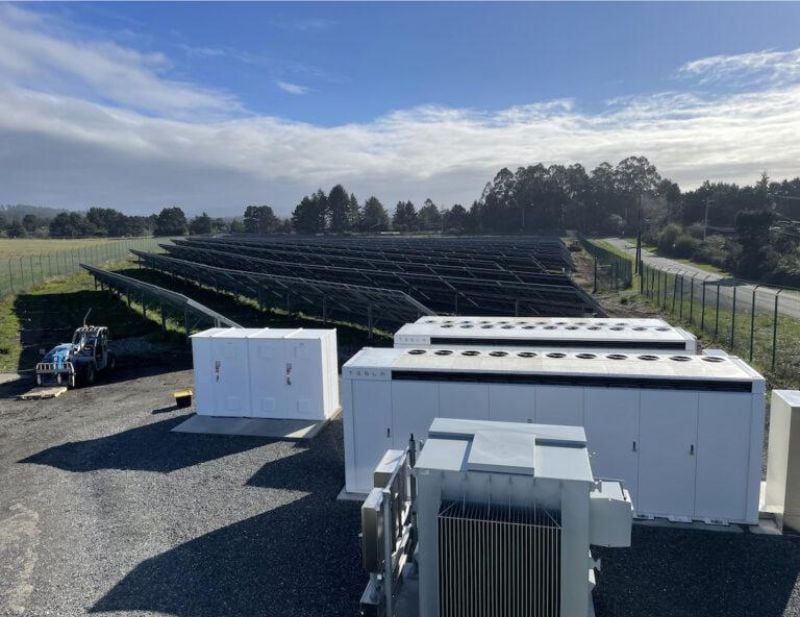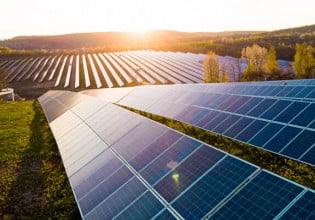PG&E to Build Hybrid Microgrid for Backup Power in Wildfire-Prone Napa Valley
PG&E will add a hybrid hydrogen fuel cell + battery energy storage system to one of its substations to provide backup power in Calistoga, California.
The California Public Utilities Commission (CPUC) recently greenlit a new microgrid proposal from Pacific Gas and Electric (PG&E), a utility providing electricity and natural gas to 16 million people in Northern and Central California.
PG&E’s Redwood Coast Airport Microgrid came online in 2022, featuring solar panels and a battery energy storage system running on Tesla Megapacks. Image used courtesy of PG&E
The company plans to develop a hybrid hydrogen fuel cell and battery storage pilot project to provide backup power during transmission-level safety power shutoffs at its Calistoga substation in California’s Napa Valley.
Calistoga, a small city of about 5,000 known for its hot springs, has a history of wildfires and continued fire hazards. According to Risk Factor, more than 1,600 properties in the city have some risk of being in a wildfire within the next three decades. The new microgrid will reduce PG&E’s use of diesel generators as temporary sources of electricity during power safety shutoff events prompted by fires and weather events, providing higher reliability through sudden shifts in energy supply and demand.
New Microgrid Boosts Renewable Energy Portfolio
According to the CPUC’s resolution document, the project will feature a hydrogen fuel cell and lithium-ion battery energy storage system to power the microgrid at the substation, starting operations by June 2024. With a capacity of 8.5 megawatts (MW), the facility can supply 293 megawatt-hours (MWh) of electricity over 48 hours. It’s expected to maintain operations for 10.5 years.
PG&E reviewed eight proposals from microgrid contractors in its bidding process, ultimately landing on Energy Vault, a Switzerland-based company offering utility-scale long-duration energy storage systems utilizing gravity and kinetic energy.
The project will cost $46.3 million and will be the first long-term clean energy substation microgrid in PG&E’s service area.
Replacing diesel generators, the new microgrid supports PG&E’s 2030 target to cut its Scope 1 (direct) and 2 (indirect) emissions by 50% and Scope 3 (value chain) emissions by 25% from 2015 levels. It also boosts PG&E’s goal to source 70% of its electricity from renewables by the decade's end, surpassing the State of California’s 60% requirement.
According to recent data from PG&E, around 40% of the company’s total electricity delivered to customers in 2022 came from renewables such as biopower, small hydroelectric, solar, and wind resources. Large-scale solar projects led its renewables mix, with over 6 gigawatts (GW) of power purchase contracts in its portfolio.
PG&E has secured contracts for battery energy storage projects totaling over 3 GW across California through 2025—of which around 1.2 GW is new battery storage capacity connected to the grid across four facilities commissioned in 2022.
Microgrids for Emergency Backup Power
Meanwhile, PG&E has been working to expand the use of distribution microgrids to power central corridors in its customer base during emergencies, storms, flooding, and wildfires.
Wildfire mitigation is a top priority for PG&E, which received the blame for several deadly wildfires over the last decade. Mounting liabilities plunged the publicly traded company into bankruptcy in 2019, when it paid $25.5 billion to settle its wildfire-related claims.
Infographic outlining PG&E’s general microgrid design and site placement. Image used courtesy of PG&E
Since then, PG&E has poured billions of dollars into preventative measures. Between 2020 and 2022, the company spent over $14 million on its wildfire mitigation plan, according to the latest document outlining its expenditures. And it plans to spend another $18.1 million this year through 2025.








